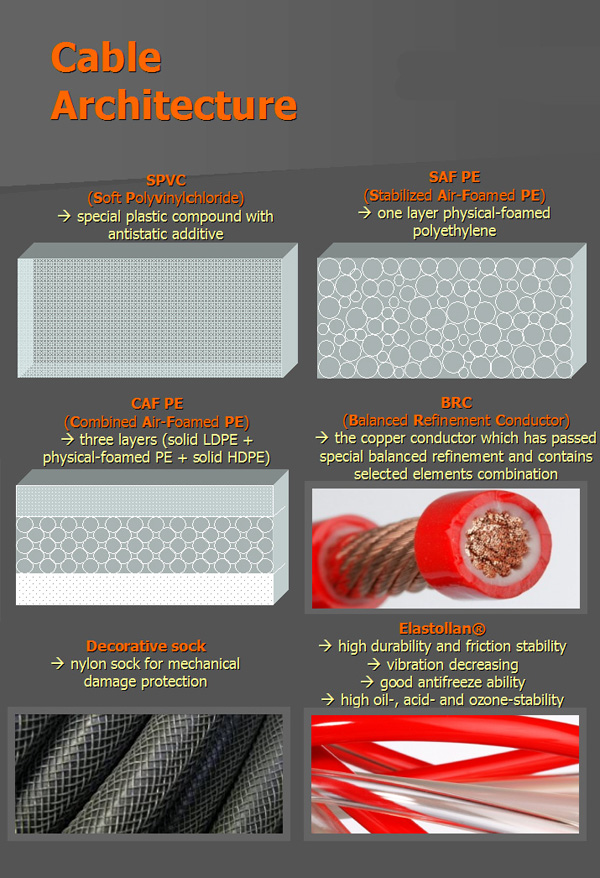Tchernov Cables
The Design of TCHERNOVAUDIO CABLES are based on three basic principles: • Using the highest quality raw materials for all elements of the cable design. |
 |
A) Philosophy authentic soundThe aim of Tchernov audio cables is to transfer all the wealth and beauty of the symphony of colors and sounds, its nuances and contrasts – while excluding any form of distortion - to the listener. Tchernov has defined the following goals, called factors of authenticity. Factors of authenticity1) Naturalness and fullness of timbre 2) Correct tonal balance B) Original materialTchernoc Cables uses the best materials with unique technical ideas. Each material is applied only where it is technologically justified. 1) BRC - Balanced Refinement Conductor Along with excellent dielectric parameters, the material has unique properties that best meet the unique requirements of operation in the home and car audio systems: • High durability and abrasion resistance Organic Concentrates - special recipe for dyeing dielectrics |
 |
C) Cable ArchitectureMusic accompanies people throughout the history of mankind. Having learned to capture the harmony, the person knowingly committed music from an inexhaustible palette of sounds of nature as objective reality. The next step was the expression of emotions and visual images in harmony with the musical instruments. Finally, man has learned to maintain and reproduce the live music. Modern technology in the field of audio aimed at improving all levels of audio accuracy, because the sound quality, ultimately, is determined by not only accuracy of the audio components, but also the quality of the connecting cables. When selecting components (including cables) must be remembered that the quality of any of them should match the level, as a result, the system will sound as good as its weakest link, even if the rest is perfect. 1) Theory vs Practice Until recently, existed a belief that it is impossible to detect distortion of sound emanating from cables, nor the ear, nor even the most modern appliances. Classical physics justifies this approach is rigid framework model of an ideal conductor. In this case, operate mostly formal electrical data - resistance, capacitance and inductance of cables. However, the mechanism of perception of sounds are remarkably sensitive instruments, and audio systems using the very assumption of an ideal conductor - straight wire with gain - is very far from reality. Cable, as a single structure, is no longer simply a conductor but a complex system, which should be regarded equally as important a component as any in an audio system. The correct approach to understanding the processes occurring in the audio, requires consideration of both physical and psychological, biological, and many other laws. To understand all the factors of the audio, you need to take into account the specific area of its application. 2) The Conductor Sound The best natural material for the transmission of audio signals is copper. The guide on quality - the level of impurity of the conductor is the usual consideration. But our numerous experiments proved that the balance of a certain number of accompanying elements might offer a better impact on the transmission of sound than their complete absence. This phenomenon characterizes the fundamental law of diversity in nature. Through painstaking research, Tchernov managed to find the best balance of copper and impurities - BRC (Balanced Refinement Conductor) - allows the cable designer to best meet the requirements of accurate transmission of sound. In addition, the impact of the skin effect in a conductor must not be under estimated - for the high, low and medium frequencies the resistance of a conductor differs. As a consequence, improperly designed audio cable, the sound quality suffers, losing detail and dynamics. To combat this effect, Tchernov uses multi stranded copper conductor in a complicated twist. By analogy with the acoustic effect of reverberation, the signal in the cable is divided into a set of components, which are distributed by the cable at different speeds. Conventional cables are not able to compensate, because the amplitude of the secondary signals by orders of magnitude below the ground, and their delay is millionths of a second. However, the human brain detects the difference in arrival time of sound through the high sensitivity of hearing to the time and phase distortions of the signal. Detection threshold is 10 microseconds! Because of this, people can easily oriented in the sound space and distinguish between the correct sound and distorted sound. 3) Physics and lyrics Projecting the cable design, we proceed from actual conditions of its subsequent operation. It is known that many processes in nature contribute to the effect of vibration. A striking example here is cables. Under the influence of external and internal sources of vibration of a so-called "microphone effect" causes static build-up on the physical properties of materials. Additional vibration load creates acoustic noise - random sound vibrations. The vibrations cause disturbances in the transmission signal, the deterioration of contact connections, interference from the interaction with the insulation material, changes in cable capacitance with the frequency of vibration and its multiple frequencies - harmonics. To combat vibrations we use insulating materials with higher damping properties: Elastollan ®, SAF PE, CAF PE, SPVC, Teflon, cotton and others. In additional the reduction of microphone effect is achieved through the use of antistatic additives that prevent the accumulation of static charge in the cable insulation. Particular attention is paid to the electromagnetic noise immunity. The design of the screens and the cable stranding with individually isolated conductors provides reliable protection from distortion from noise in electronics. These technical solutions determines the qualitative audible difference between other cable and TCHERNOVAUDIO CABLES, you can easily hear for yourself ... For more information click here. |
